#homoeroticism in the Biblical world
Text



I got a very bright study room for this afternoon. I have a meeting with my advisor later, so I booked a room in order to be able to talk and not disturb anyone.
We’ll be talking about my last paper of my BA Thesis. I kind of can’t believe I made it this far. I’m really proud of myself. I’m hoping to end on a strong note with the best mark yet.
#aelstudies#academia#academia aesthetic#studyblr#university studyblr#ba thesis#homoeroticism in the Biblical world#university student#university studyspo#study motivation#studyspo
88 notes
·
View notes
Text
ive decided im going to start doing this 'book opinion' thing differently since making one big recap post every month isnt working for me - instead of that i will simply make text posts about whatever im reading as i go ! 👍 just the regular type of bookposting i suppose . back to factory settings
this week i finished stephen mitchells adaptation of the epic of gilgamesh and if youre unfamiliar with the story, like i was, i cant recommend it enough ! so short and simple and it includes a full analysis that is pretty insightful but still very easy to read . im so fond of stories that remind you that people have always been people, that there are things thay have been the same for thousands of years ... it should be a little depressing but i find it comforting . so many fascinating things in there, from the homoeroticism to the morally questionable hero and the fact that it contains a flood narrative nearly identical to the biblical one ... excited to read more versions in the future, especially herbert masons verse narrative
and right now im reading the bloody chamber and other stories by angela carter and having my world rocked and destroyed and rebuilt . ive only read three stories so far, but its just stunning beyond words, the titular story has to be one of the best short stories ive ever read . mrs angela you are the only person who can handle my complex ideas about female sexuality amen
6 notes
·
View notes
Note
Three entirely random unrelated thoughts/observations: 1) throwing all that biblical imagery in there and then denying us Judas betraying Jesus with a kiss??? For shame!!! 2) when Gaon's going through the Highlight Reel of Homoeroticism, the cards by the blueprints are now arranged in the shape of the court, right? 3) in my head, when Gaon returns home after the end of ep 16, he finds Elijah's painting of him inside...
1. i know oh my god they could've kissed!!!!!!!!!! but no!!!!!!!! the world is still bigoted. i cannot believe, smh, lmao. 😭😭
2. and yes, i believe they're the shape of the court. the first time he built them, it was just a regular triangular shape, but he matched the blueprints with them instead.
3. i SWEAR to god when gaon went into elijah's room, i fully expected the paining to be in there. literally as he was walking in, i was like 'oh he'll see it!!!' and then nope. HOWEVER, it does mean that elijah probably took it with her if it's not there. (yohan probably told her to, hmm?? lmao)
we know gaon knows that yohan loves him, but it's gaon's turn to find out elijah loves him, too!!!!!!!!!
32 notes
·
View notes
Text
DrSilverfish S11 Meta Masterpost
Because I am doing some blog housekeeping, here is the watch-along week-by-week list of my meta for S11, a season I felt quite ambivalent about at the time (largely due to the handling of the Amara character) but which, nevertheless, undertook some amazing narrative work:
1) The fall-out from Crowley and Demon!Dean’s “summer of love” bore interesting fruit in the form of a child (released into the universe through the Mark of Cain) - Amara. So much subtext here (which I must return to and write about more fully at some point). In subtext, we could say that Dean’s dark affair with Crowley in S10 “unlocked” his queer heart a little further, allowing him to connect more deeply with his “feminine” side symbolised by the eventual “reward” of the return of his Mother (yeah this equation of “feminine side” with queerness in men is, on one level, a reductionist cliche, but one often drawn on, symbolically, in filmic narrative). Amara (Dean’s, and God’s, anima, in a Jungian reading) bears the Mark of Cain over her heart for a reason.
2) The faux thrall-bond with Amara vs the true profound bond with Castiel - all the Destiel subtext this mirroring unleashed.
3) The unfridging of the feminine principle in the SPN universe, on a macrocosmic level (God’s sister) and then on a micro-cosmic level (her gift to Dean of the return of his mother Mary). This was a brilliant and audacious narrative move, as well as a lovely piece of meta-narrative (the text’s own commentary on itself) given that the show began with the fridging of the Winchesters’ mother and has often adopted a Biblically inspired misogyny towards female power. This unfridging staked out the narrative form of the Dabb era as the Ouroboros, the story returning (especially psychologically) to the start (the origin fridging of Mary Winchester, but also, a continuous unfolding, to include, as we can see by S14, the fall of Castiel). In swallowing its own tail, the narrative has really blossomed and evolved from this new origin point of 11x23.
DrSilverfish S11 Meta
0) 11x01 Flower Meta (end comment on a multi-authored post)
http://drsilverfish.tumblr.com/post/130804921694/f-ckyeahfutbol-johanaviterito
0b) 11x01 Crowley’s Orgy and Queer Representation (end comment on a multi-authored discussion post)
http://drsilverfish.tumblr.com/post/130839771649/rainbofiction-f-ckyeahfutbol
1) 11x01 Title Card: The Darkness and Gnosticism
http://drsilverfish.tumblr.com/post/130878876784/the-darkness-and-gnosticism
2) 11x02 Form and Void: Or the Subterranean Lake of Queerness
http://drsilverfish.tumblr.com/post/131249527014/11x02-form-and-void-or-the-subterranean-lake-of
3) Supernatural and the Monstrous Girl: Amara in Context
http://drsilverfish.tumblr.com/post/131343979699/supernatural-and-the-monstrous-girl-amara-in
4) 11x02 Form and Void - Castiel’s “Moe” (multi-authored discussion)
http://drsilverfish.tumblr.com/post/131357510284/impostoradult-spn-icanteven-vegancumsplat
5) Feminism and Supernatural (my end-text addition to a multi-authored gif-post)
http://drsilverfish.tumblr.com/post/131437002174/f-ckyeahfutbol-ibelieveinthelittletreetopper
6) Amara’s Symbolic Colours (my end-text addtion to a multi-authored discussion)
http://drsilverfish.tumblr.com/post/131643096894/messier666-justanotheridijiton0
7) 11x03 The Bad Seed: An Angel and a Demon Walk into a Bar
http://drsilverfish.tumblr.com/post/131679550389/an-angel-and-a-demon-walk-into-a-bar
8) 11x03 The Bad Seed: Homoeroticism and Violence (my end-text addition to a multi-authored discussion)
http://drsilverfish.tumblr.com/post/131777948139/in-the-war-film-a-soldier-can-hold-his-buddyas
9) 11x03 The Bad Seed: Amara’s Rainbow (my end-text addition to a multi-authored discussion)
http://drsilverfish.tumblr.com/post/131905197044/hey-do-you-have-any-thoughts-about-baby-amaras
10) 11x04 (Baby) and John Winchester’s Ghost
http://drsilverfish.tumblr.com/post/132236207279/11x04-and-john-winchesters-ghost
11) 11x04 Baby and the State of Dean’s Soul
http://drsilverfish.tumblr.com/post/132338761909/11x04-baby-and-the-state-of-deans-soul
12) Samuel, Sam, Sammy in 11x05 Thin Lizzie
http://drsilverfish.tumblr.com/post/132596039804/samuel-sam-sammy-in-11x05
13) Omnis Satanica Potestas 11x06 Our Little World
http://drsilverfish.tumblr.com/post/133101496179/omnis-satanica-potestas-11x06
14) Our Little World and Familial Relationships (11x06)
http://drsilverfish.tumblr.com/post/133135247079/our-little-world-and-familial-relationships
15) Amara and Castiel (11x06 Our Little World)
http://drsilverfish.tumblr.com/post/133295635934/amara-and-castiel
16) 1x14 Nightmare: The Winchester Childhood Subtext (Back at the Start)
http://drsilverfish.tumblr.com/post/133481782594/1x14-nightmare-the-winchester-childhood-subtext
17) 11x07 Plush Review
http://drsilverfish.tumblr.com/post/133552060279/11x07-plush-reviewed
18) A Note on 9x15 Thinman/ 11x08 Just My Imagination Parallels
http://drsilverfish.tumblr.com/post/134553476384/dustydreamsanddirtyscars-09x15-thinman-11x08
19) 11x11 Music Meta: Into the Mystic
http://drsilverfish.tumblr.com/post/138299189169/into-the-mystic-11x11
20) Rock, Paper, Scissors (as Metaphor) in 11x13 Love Hurts
http://drsilverfish.tumblr.com/post/139114049939/whyjm-sillybubbies-victory-for-dean-and
21) “I Read a Lot of Flash Gordon” 11x14 The Vessel
http://drsilverfish.tumblr.com/post/139567721629/i-read-a-lot-of-flash-gordon
22) 11x15 Beyond the Mat: Wrestling and Queer-Coding (my end-text addition to a mullti-authored discussion)
http://drsilverfish.tumblr.com/post/140037458834/postmodernmulticoloredcloak-mittensmorgul
23) Safe House (11x16): A Few Musings
http://drsilverfish.tumblr.com/post/141629077204/safe-house-11x16-a-few-musings
24) The Bro-Dependency Ouroboros
http://drsilverfish.tumblr.com/post/142119230659/the-bro-dependency-ouroboros
25) 11x17 Red Meat: Winchester Romeo and Juliette
http://drsilverfish.tumblr.com/post/142131853759/winchester-romeo-and-juliete
26) 11x19 The Closet in The Chitters
http://drsilverfish.tumblr.com/post/143679500254/the-closet-in-the-chitters-11x19
27) Things to Love About 11x20 (Don’t Call Me Shurley) (Music Meta)
http://drsilverfish.tumblr.com/post/143908073654/things-to-love-about-11x20
28) Key to the Kingdom 11x20 (10x11 There’s No Place Like Home mirroring)
http://drsilverfish.tumblr.com/post/143949226914/key-to-the-kingdom-11x20
29) Don’t Call Me Shurley (title meta - my end-text addition to a mullti-authored discussion)
http://drsilverfish.tumblr.com/post/144213460859/venusdebotticelli-messier51-kinda-mad-now
30) We Happy Few 11x22
http://drsilverfish.tumblr.com/post/144616955809/we-happy-few-11x22
31) 11x22 Music Meta - Bridge of Sighs
http://drsilverfish.tumblr.com/post/144672416269/11x22-bridge-of-sighs
32) 11x23 Alpha and Omega
http://drsilverfish.tumblr.com/post/144951980874/the-darkness-and-gnosticism
33) Form and Void to Alpha and Omega
http://drsilverfish.tumblr.com/post/144961871804/form-and-void-to-alpha-and-omega
34) “You’re Our Brother, Cas” (11x23)
http://drsilverfish.tumblr.com/post/145119084109/youre-our-brother-cas
35) “We Happy Few... We Band of Brothers” (11x22 and 11x23)
http://drsilverfish.tumblr.com/post/145129507509/we-happy-few-we-band-of-brothers
76 notes
·
View notes
Text
sludge7 hat dich in einem Eintrag erwähnt
@mangeme I was smoking weed and reading the wikipedia page for the disciple Jesus loved. I’m simple
thank you for being inspirational as always. apparently its from “Homoeroticism in the Biblical World: A Historical Perspective, 2007″ & it only costs about 15$. i will absolutely treat myself bcs I love myself just like God loves me
1 note
·
View note
Text
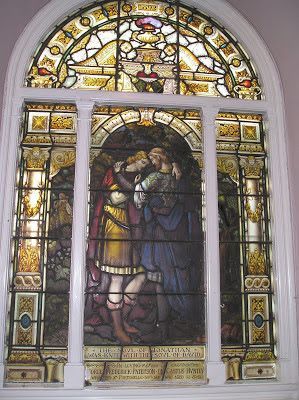
David and Jonathan
Jonathan was the son of Saul, king of Israel, of the tribe of Benjamin, and David was the son of Jesse of Bethlehem, of the tribe of Judah, and Jonathan's presumed rival for the crown. David became king. The covenant the two men had formed eventually led to David, after Jonathan's death, graciously seating Jonathan's son Mephibosheth at his own royal table instead of eradicating the former king Saul's line.
David (Hebrew: דָּוִד; Dāwīḏ or David) and Jonathan (Hebrew: יְהוֹנָתָן; Yəhōnāṯān or Yehonatan) were heroic figures of the Kingdom of Israel, who formed a covenant recorded in the books of Samuel.
The biblical text does not explicitly depict the nature of the relationship between David and Jonathan. The traditional and mainstream religious interpretation of the relationship has been one of platonic love and an example of homosociality. Some later Medieval and Renaissance literature drew upon the story to underline strong personal friendships between men, some of which involved romantic love.
In modern times, some scholars, writers, and activists have emphasized elements of homoeroticism in the story. A number of groups made up of gay Roman Catholics trying to reconcile their faith with their sexuality have also adopted the names: Davide e Gionata (Italy), and David et Jonathan (France).
In the Bible
The relationship between David and Jonathan is mainly covered in the Hebrew Bible Book of Samuel. The episodes belong to the story of David's ascent to power, which is commonly regarded as one of the sources of the Deuteronomistic history, and to its later additions.
David, the youngest son of Jesse, slays Goliath at the Valley of Elah where the Philistine army is in a standoff with the army of King Saul (Jonathan's father). David's victory begins a rout of the Philistines who are driven back to Gath and the gates of Ekron. Abner brings David to Saul while David is still holding Goliath's severed head. Jonathan, the eldest son of Saul, has also been fighting the Philistines. Jonathan takes an immediate liking to David and the two form a covenant:
Now it came about when he had finished speaking to Saul, that the soul of Jonathan was knit to the soul of David, and Jonathan loved him as himself. Saul took him that day and did not let him return to his father's house. Then Jonathan made a covenant with David because he loved him as himself. Jonathan stripped himself of the robe that was on him and gave it to David, with his armor, including his sword and his bow and his belt. So David went out wherever Saul sent him, and prospered; and Saul set him over the men of war. (NASB)
Death of JonathanEdit
As Saul continues to pursue David, the pair renews their covenant, after which they do not meet again. Eventually Saul and David are reconciled. Jonathan, however, is slain on Mt. Gilboa along with his two brothers Abinadab and Malchi-shua, and there Saul commits suicide. David learns of Saul and Jonathan's death and chants a lament, which in part says:
Saul and Jonathan, beloved and pleasant in their life, And in their death they were not parted; They were swifter than eagles, They were stronger than lions ... How have the mighty fallen in the midst of the battle! Jonathan is slain on your high places. I am distressed for you, my brother Jonathan; You have been very pleasant to me. Your love to me was more wonderful than the love of women. How have the mighty fallen, And the weapons of war perished!
The sages characterized the relationship between Jonathan and David in the following Mishnah:
“Whenever love depends on some selfish end, when the end passes away, the love passes away; but if it does not depend on some selfish end, it will never pass away. Which love depended on a selfish end? This was the love of Amnon and Tamar. And which did not depend on a selfish end? This was the love of David and Jonathan. (Avot 5:16)"
Rabbi Shimon ben Tzemach Duran (Spain, North Africa 14th-15th century) delineated the significance of this mishnah:
“Anyone who establishes a friendship for access to power, money, or sexual relations; when these ends are not attainable, the friendship ceases…love that is not dependent on selfish ends is true love of the other person since there is no intended end.” (Magen Avot – abridged and adapted translation)
A platonic interpretation for the relationship between David and Jonathan has been the mainstream view found in biblical exegesis, as led by Christian writers. This argues that the relationship between the two, although strong and close, is ultimately a platonic friendship. The covenant that is made is political, and not erotic; while any intimacy is a case of male bonding and homosociality.
David and Jonathan's love is understood as the intimate camaraderie between two young soldiers with no sexual involvement. The books of Samuel do not actually document physical intimacy between the two characters aside from "kissing," while the euphemisms the Bible uses for sexual relations are missing, and nothing indicates that David and Jonathan had a sexual relationship. Neither of the men is described as having problems in their heterosexual married life. David had an abundance of wives and concubines as well as an adulterous affair with Bathsheba, and apparently suffered impotence only as an old man, while Jonathan had a five-year-old son at his death.
In response to the argument that homoeroticism was edited out, some traditionalists who subscribe to the Documentary Hypothesis note the significance of the lack of censoring of the descriptions at issue, in spite of the Levitical injunctions against homoerotic contact. Gagnon notes, "The narrator’s willingness to speak of David’s vigorous heterosexual life (compare the relationship with Bathsheba) puts in stark relief his (their) complete silence about any sexual activity between David and Jonathan."
Presuming such editing would have taken place, Martti Nissinen comments, "Their mutual love was certainly regarded by the editors as faithful and passionate, but without unseemly allusions to forbidden practices ... Emotional and even physical closeness of two males did not seem to concern the editors of the story, nor was such a relationship prohibited by Leviticus." Homosociality is not seen as being part of the sexual taboo in the biblical world.
Medieval and Renaissance
Medieval literature occasionally drew upon the biblical relationship between David and Jonathan to underline strong personal and intimate friendships between men. The story has also frequently been used as a coded reference to homoerotic relations when the mention was socially discouraged or even punished.
The anonymous Vita Edwardi Secundi, c. 1326 AD, wrote: "Indeed I do remember to have heard that one man so loved another. Jonathan cherished David, Achilles loved Patroclus." And thus, King Edward II wept for his dead lover Piers Gaveston as: "... David had mourned for Jonathan.". Similarly, Roger of Hoveden, a twelfth-century chronicler, deliberately drew comparisons in his description of “The King of France (Philip II Augustus) [who] loved him (Richard the Lionheart) as his own soul.”
The Renaissance artists Donatello and Michelangelo both brought out strong homoerotic elements in their respective sculptures depicting the youthful David.
Modern interpretations
Some modern scholars and writers have interpreted the love between David and Jonathan as more intimate than platonic friendship. This was first pioneered by Tom Horner, then adopted by John Boswell. This interpretation views the bonds the men shared as romantic love, regardless of whether the relationship was physically consummated. Jonathan and David cared deeply about each other in a way that was arguably stronger and more intimate than a platonic friendship.
David's praise in 2 Samuel 1:26 for Jonathan's 'love' (for him) over the 'love' of women is considered evidence for same-sex attraction, along with Saul's exclamation to his son at the dinner table, "I know you have chosen the son of Jesse - which is a disgrace to yourself and the nakedness of your mother!" The "choosing" (bahar) may indicate a permanent choice and firm relationship, and the mention of "nakedness" (erwa) could be interpreted to convey a negative sexual nuance, giving the impression that Saul saw something indecent in Jonathan and David's relationship.
Some also point out that the relationship between the two men is addressed with the same words and emphasis as other love relationships in the Hebrew Testament, whether heterosexual or between God and people: e.g. ahava or אהבה.
When they are alone together, David confides that he has "found grace in Jonathan's eyes", a phrase proponents[who?] say normally refers to romantic or physical attraction. However, this phrase is often used in nonromantic contexts as well. Throughout the passages, David and Jonathan consistently affirm and reaffirm their love and devotion to one another, and Jonathan is willing to betray his father, family, wealth, and traditions for David.
That there is more than mere homosociality in the dealings of David and Jonathan is asserted by two recent studies: the biblical scholar Susan Ackerman, and the Orientalist Jean-Fabrice Nardelli. Ackerman and Nardelli argue that the narrators of the books of Samuel encrypted same-sex allusions in the texts where David and Jonathan interact so as to insinuate that the two heroes were lovers. Ackerman explains this as a case of liminal, viz. transitory, homosexuality, deployed by the redactors as a textual means to assert David's rights against Jonathan's: the latter willingly alienated his princely status by bowing down (1 Samuel 20:41), sexually speaking, to the former. Nardelli disagrees and argues that the various covenants Jonathan engaged David into as the superior partner gradually elevated David's status and may be seen as marriage-like.
Susan Ackerman also believes that there is highly eroticized language present in six different sections in the Hebrew Bible in regards to the relationship of David and Jonathan. The six sections she mentions are 1) David and Jonathan's first meeting in 1 Sam. 18:1-18:4 2) the most important description of David and Jonathan's first few meetings in 1 Sam 19:1-19:7. 3) the incident of Saul berating Jonathan for his friendship with David in 1 Sam 20:30-20:34 4) David fleeing from the court of King Saul in 1 Sam. 20:1-20:42 5) the description of David and Jonathan's final meeting in 1 Sam. 23:15-23:18 and 6) David's lament (the Song of the Bow) for Saul and Jonathan. Of these six examples, Ackerman identifies the most important example being the last one (the Song of the Bow) due to David's assertion that Jonathan's love to David "was more wonderful than the love of women"....
Picture: David and Jonathan, windowfrom St. Mark's Portobello, Edinburgh, Scotland, 1882
Source from Wikipedia
1 note
·
View note
Text
Yin & Yang: The Unity of Opposites and the Omegamon Foreshadowing in Our War Game
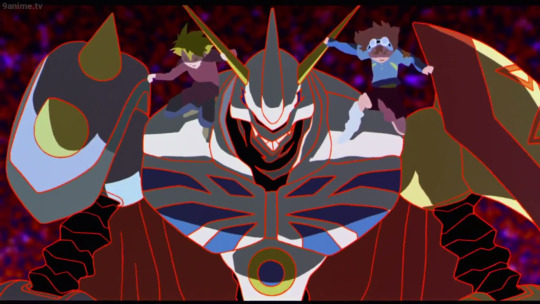
This entire film (and I’d argue the whole of Digimon Adventure) was leading up to this moment. The unifying of Taichi and Yamato, two sides of the same coin, Yin & Yang, as one almighty force.
(Please make note of what side of Omegamon each boy is standing on, as it will be relevant throughout this post)
Throughout Adventure, the references to Taichi and Yamato being Yin & Yang and the foreshadowing to them being meant to come together as a unit are definitely present. However, in Our War Game I feel it gets turned up to 11.
Taichi and Yamato’s outfits
Many people in the fandom have already pointed out how Taichi and Yamato’s outfits in 02 as well as Tri hint at thei Yin and Yang nature, but in case you are not familiar I will reiterate here:
First, it starts with Taichi and Yamato wearing their Digivices on opposite sides of their waist in 01 (and presumably this continues on throughout the rest of the series). This information comes from one of the CD Dramas.
Then you have their 02 outfits

Taichi has his jacket undone while Yamato does not, Taichi has all of his button done up while Yamato has the top button undone, Taichi is wearing his shirt out while Yamato has his shirt tucked in.
Then we have their Tri outfits
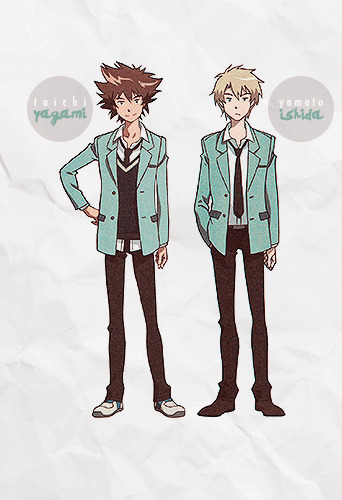
Once again, Taichi has his shirt out while Yamato has his tucked in. You can’t tell in this picture but if you watch Tri you’ll notice that Taichi is wearing the shirt with short sleeves while Yamato is wearing the one with long sleeves. Taichi also wears the vest underneath his Jacket while Yamato does not.
(completely irrelevant side note, but while doing this I noticed that Taichi, Yamato and Mimi are the only ones who wear their jackets unbuttoned in Tri and this pleases my OT3 senses :P)
So now back to Our War Game

(Sorry, I know that image looks dumb but I wanted to try to put two decent shots of their whole outfits next to each other for reference and my skills in this area are seriously lacking)
While Taichi’s outfit is pretty much the same as in Adventure (with a few minor changes), Yamato’s top has changed completely. I believe that this was done in order to have Yamato and Taichi’s outfits contrast each other to the max.
Okay so, first off I want to point out the colors. Now Yamato’s pants look more grey in this shot but there are shots where they look more blue:

So, I’m convinced they are blue jeans. So in regards to color, Taichi is wearing brown on the bottom and blue on top, and Yamato is wearing brown on top and blue on the bottom.
Also, Yamato is wearing pants, while Taichi is wearing shorts, and Yamato’s top is a button up one while Taichi’s tops are pullovers. Furthermore Yamato is only wearing one shirt (or at least we can assume) while Taichi is wearing at least two (possibly 3, he’s wearing a yellow top under his blue one and I can’t tell if the long sleeved shirt is part of the yellow top or a separate top). Also, Yamato has shoes and Taichi doesn’t :P
The framing of Taichi and Yamato
Moving on from their character designs, I’d like to talk about the choices Hosoda made in terms of Yamato and Taichi’s placements within the frame when they are on screen. (This post is about to get very very very picture heavy).

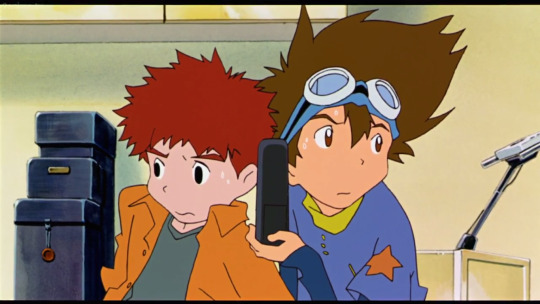
Okay so here we have the first interaction between Taichi’s party and Yamato’s party. Notice how Taichi and Yamato are on opposite sides of the screen in their shots. Furthermore they are on the correct sides that they will be on when Omegamon first appears, with Taichi on the Right (just like how he is on the right shoulder of Omegamon) and Yamato on the left (just like how he is on the left shoulder).
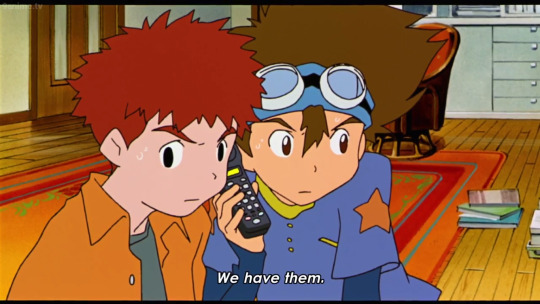

And it continues.
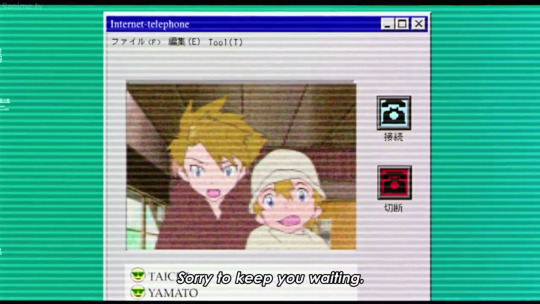

Again they are on opposite sides of the screen on their “skype” chat (I know it’s not skype :P). (Also, side note, notice Taichi and Yamato’s names at the bottom and their emoji’s are wearing shades lol)
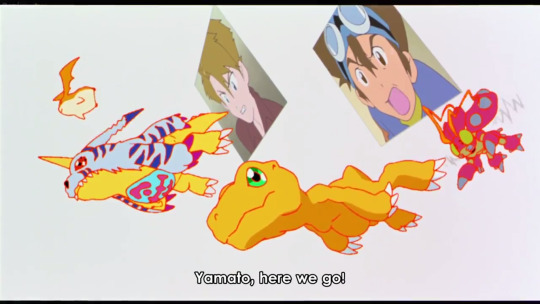
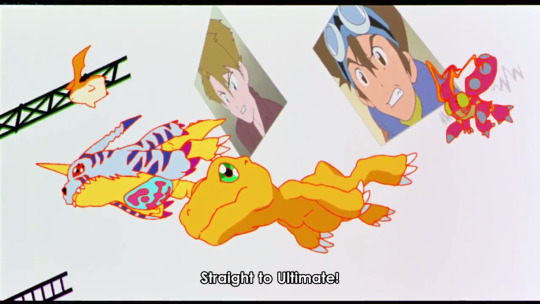
Again, just them on the right and left of the screen (don’t worry it get’s more interesting in a sec).

Okay so this is MY FAVOURITE SHOT RIGHT HERE!! Taichi and Yamato are literally over lapping each other with Wargreymon on the right (just as the Grey Sword will be on the right when Omegamon is formed) and MetalGarurumon on the left (just as the Garuru Canon will be on the left). It’s just so PERFECT!!
East and West
So, there is an interesting scene in this movie just before the final battle with Diablomon where Koushiro is reading out mail from around the world. He reads two different emails and states where they are coming from.


One is to Wargreymon and is from Costa Rica, the other is for MetalGarurumon and is from the Philippines.

This is interesting because these location are on opposite sides of the North Pacific Ocean, with the Philippines in the East (GPS coordinates NE) (left) and Costa Rica in the West (GPS coordinates NW) (Right). This is even more interesting because the East is often associated with Yin while the West is associated with Yang. So where the mail is coming from and who it is addressed to lines up with Yamato and Taichi’s respective sides of Yin & Yang.
I don’t know if this was intended or not but it’s really interesting anyway. So, many people probably know about the whole East–West dichotomy which discusses the differences and divisions between the Eastern and Western worlds. But since the invention of the internet we have seen the divisions breaking down, the whole world is coming together in ways that was never previously possible, to do things we previously couldn’t (that’s not to say divisions don’t still exist but huge strides have been made in creating a unified earth).


I think it’s cool to think that that was part of Hosoda’s intention when he made all of the kids from around the world come together to form the body of Omegamon.
And since I’m talking East and West and have pointed out how they correspond to Taichi and Yamato I’d like to take a moment to point out the similarities between Taiyama and the two men in a famous poem titled "The ballad of East and West" (I have no idea if Hosoda knew about this poem, I doubt he did, but it would be kind of amazing if he did).
So first, the most famous lines from this poem (also the opening and closing verses):
Oh, East is East and West is West, and never the twain shall meet,Till Earth and Sky stand presently at God's great Judgment Seat;But there is neither East nor West, Border, nor Breed, nor Birth,When two strong men stand face to face, though they come from the ends of the earth!
(I’ll be quoting GradeSaver for this part cause I’m too lazy to write a whole thing about this and honestly it just speaks for itself. You can find more info and my sources here ).
“The story concerns two equally-matched warriors, and their rivalry that turns into great mutual respect and admiration. The theme of the poem is that men of each territory can put aside their differences and appreciate each other’s universal qualities of bravery, nobility, and rectitude.
The line regarding East and West is derived from Psalm 103:12: “Look how wide also is the east from the west: so far hath he set our sins from us”. (Look more biblical references, I looked briefly into the meaning of these lines and it’s really just talking about how vast the love of God is so I don’t think there is anything to dissect about it, but I may come back to it later if I think of something).
Another important element in the poem is the ritual of gifting, which comes after the two men begin to realize how much they have in common and how much they value the other's courage and might.
A final significant element is the presence, as many critics and readers have noted, of an element of homoeroticism in the men's encounter. This is not easily dismissed”
So, yeah, lot’s of similarities here to Taichi and Yamato.
The forming of Omegamon


Taichi and Yamato talking about how they won’t give up just before the final fight.

And all of these creative choices, from their outfits, to the references to East and West, were all here to foreshadow and emphasize this beautiful moment!


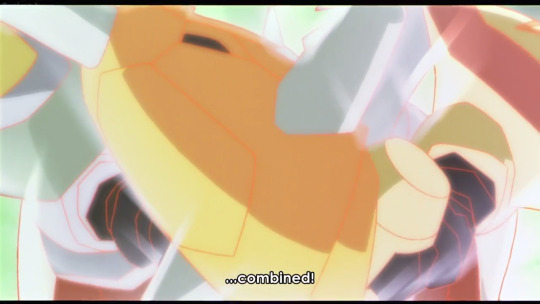
The unity of opposites
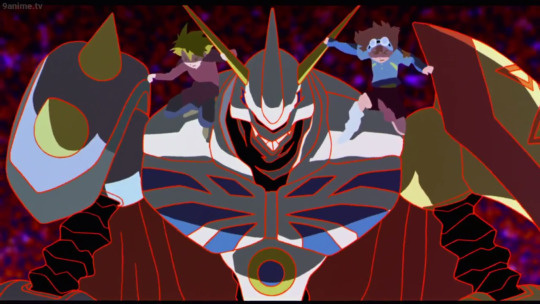
Omegamon!!
#our war game musings#our war game#taiyama#taichi x yamato#digimon adventure#omegamon#omnimon#taichi yagami#yamato ishida#the ballad of east and west
19 notes
·
View notes
Text


More!
BA Thesis!!
Work!!!

Hello Monday!!
This afternoon I was supposed to have my first advisor meeting for my BA thesis. However, my advisor was having a busy day, so we rescheduled it for tomorrow afternoon.
I am alright with this, as it gives me more time to finish the current chapter I am working through. So I packed up my things, got a London Fog from the campus coffee shop, and am planning to work in the library for a couple of hours.
Books:
How to Write a BA Thesis (2nd Ed.) - Charles Lipson
Homoeroticism in the Biblical World (Trans. Kirsi Stjerna) - Martti Nissinen
Sex in Antiquity - Mark Masterson et al.
#aelstudies#Homosexuality in the Biblical World#featuring#london fog#ba thesis#hello monday#university studyblr#university#university studyspo#studyblr#studyspo#study motivation#how to write a ba thesis#sex in antiquity#homoeroticism in the biblical world
3 notes
·
View notes
Photo

The Bible Never Condemned Homosexuality, live your life. These two verses in Leviticus read as follows in the King James Version: “Thou shalt not lie with mankind as with womankind; it is an abomination.” (Leviticus 18:22) “If a man also lie with mankind as he lieth with a woman, both of them have committed an abomination; they shall surely be put to death; their blood be upon them.” (Leviticus 20:13) Before delving into these two verses, it would be helpful to read How Language is Interpreted, which is part of the discussion of Romans 1. If we wish to understand the true meaning of these verses, we must look at their context, both textual and historical. Until we understand what prompted these rules in Old Testament times, we will not be able to determine if the rules should be applied to the case of two people in committed, loving relationship. Leviticus 18:2-3, 18:24, and 20:23. The text itself gives us a big clue as to the intended meaning. Three different times we are specifically told that the rules set forth in chapters 18 and 20 are meant to prevent the Israelites from doing what the Egyptians and Canaanites did. The term Canaanites refers to the group of nations who lived in the land into which the Israelites migrated when they left Egypt. It follows, therefore, if we can determine what type of homosexual behavior was common among the Canaanites and Egyptians, we will better understand what these verses were meant to prohibit. Some recent scholarship has called this truism into question (e.g., see the article The end of the male cult prostitute: A literary-historical and sociological analysis of Hebrew qades-qadesim [Source: Congress Volume, pages 37-80, E.J. Brill, Leiden, 1997] by Phyllis A. Bird, published in the Vetus Testamentum, 66). But even if these practices were not as prevalent as scholars once thought, the biblical text indicates the biblical authors believed they were, and their writings are based on that factual premise. See also, Homoeroticism in the Biblical World by Martti Nissinen, pages 41-42, for a discussion of this. (at House of Rainbow Office London)
0 notes